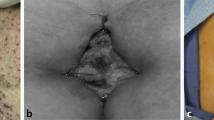Abstract
Background
Investigating minimally invasive methods for treatment of pilonidal disease, we reviewed the techniques and the results of phenol treatment of pilonidal disease in the medical literature.
Methods
A Pubmed search for all English language written papers and abstracts published between January 1964 and September 2007.
Results
Mean time to return to work is 2.3 ± 3.8 days and mean healing time is 20 ± 14 days. Overall success rate is 87 ± 10% with a mean follow-up of 2.0 ± 1.1 years. The most common postoperative complications after phenolization are development of abscesses and cellulites. The incidence of morbidities was mean 8.9 ± 4.7%.
Conclusions
Success rate looks better particularly in the cases that have 1–3 sinus orifices and comparable with the surgical methods. Though healing time of the wound is long, the procedure apparently lessens the time off work. Although results of this review indicate that phenol treatment may be beneficial for pilonidal disease, the lack of randomized studies results in only weak evidence. There is also the need for longer-term follow-up data.
Similar content being viewed by others
References
McCallum I, King PM, Bruce J (2007) Healing by primary versus secondary intention after surgical treatment for pilonidal sinus. Cochrane Database Syst Rev. 17;CD006213
Akinci OF, Bozer M, Uzunkoy A, Duzgun SA, Coskun A (1999) Incidence and aetiological factors in pilonidal sinus among Turkish soldiers. Eur J Surg 165:339–342
Pilonidal sinus: is surgery alone enough? (2003) Colorectal Dis 5:205 (Editorial)
Abdul-Ghani AK, Abdul-Ghani AN, Ingham Clark CL (2006) Day-care surgery for pilonidal sinus. Ann R Coll Surg Engl 88:656–658
Petersen S, Aumann G, Kramer A, Doll D, Sailer M, Hellmich G (2007) Short-term results of Karydakis flap for pilonidal sinus disease. Tech Coloproctol 11:235–240
Armstrong JH, Barcia PJ (1994) Pilonidal sinus disease. The conservative approach. Arch Surg 129:914–917
Odili J, Gault D (2002) Laser depilation of the natal cleft—an aid to healing the pilonidal sinus. Ann R Coll Surg Engl 84:29–32
Schulze SM, Patel N, Hertzog D, Fares LG 2nd (2006) Treatment of pilonidal disease with laser epilation. Am Surg 72:534–537
Kaymakcioglu N, Yagci G, Simsek A et al (2005) Treatment of pilonidal sinus by phenol application and factors affecting the recurrence. Tech Coloproctol 9:21–24
Dogru O, Camci C, Aygen E, Girgin M, Topuz O (2004) Pilonidal sinus treated with crystallized phenol: an eight-year experience. Dis Colon Rectum 47:1934–1938
Schneider IH, Thaler K, Köckerling F (1994) Treatment of pilonidal sinuses by phenol injections. Int J Colorectal Dis 9:200–202
Vara-Thorbeck R, Mekinassi K, Berchid S (1990) Phenol treatment of pilonidal sinuses. Zentralbl Chir 115:777–780
Stansby G, Greatorex R (1989) Phenol treatment of pilonidal sinuses of the natal cleft. Br J Surg 76:729–730
Kelly SB, Graham WJ (1989) Treatment of pilonidal sinus by phenol injection. Ulster Med J 58:56–59
Hegge HG, Vos GA, Patka P, Hoitsma HF (1987) Treatment of complicated or infected pilonidal sinus disease by local application of phenol. Surgery 102:52–54
Duchateau J, De Mol J, Bostoen H, Allegaert W (1985) Pilonidal sinus. Excision–marsupialization–phenolization? Acta Chir Belg 85:325–328
Blumberg NA (1978) Pilonidal sinus treated by conservative surgery and the local application of phenol. S Afr J Surg 16:245–247
Shorey BA (1975) Pilonidal sinus treated by phenol injection. Br J Surg 62:407–408
Rickles JA (1974) Ambulatory surgical management of pilonidal sinus. Am Surg 40:237–240
Stephens FO, Sloane DR (1969) Conservative management of pilonidal sinus. Surg Gynecol Obstet 129:786–788
Stewart TJ, Bell M (1969) The treatment of pilonidal sinus by phenol injection. Ulster Med J 38:167–171
Stephens FO, Sloane DR (1968) Management of pilonidal sinus—a modern approach. Med J Aust 1:395–396
Maurıce BA, Greenwood RK (1964) A conservative treatment of pilonidal sinus. Br J Surg 51:510–512
Author information
Authors and Affiliations
Corresponding author
Rights and permissions
About this article
Cite this article
Kayaalp, C., Aydin, C. Review of phenol treatment in sacrococcygeal pilonidal disease. Tech Coloproctol 13, 189–193 (2009). https://doi.org/10.1007/s10151-009-0519-x
Received:
Accepted:
Published:
Issue Date:
DOI: https://doi.org/10.1007/s10151-009-0519-x




